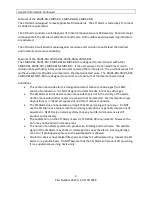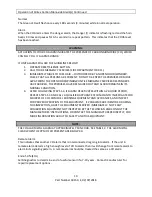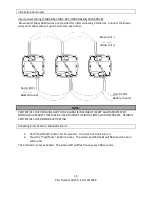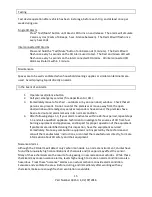
15
Part Number
18150, E, 02/07/2018
Testing
Test device operation after vehicle has been in storage, before each trip, and at least once per
week during use.
Single CO Alarm
Press “Test/Mute” button until Green LED turns on and release. The alarm will simulate
2 alarm cycles (2 sets of 4 Beeps, 5 sec. Silence between). The Red LED will flash once
every 5 seconds.
Interconnected CO Alarms
Press and hold the “Test/Mute” button for 60 seconds (1 minute). The Red LED will
flash once every 5 seconds on the CO Alarm used to test. The Red and Green LED will
flash once every 5 seconds on the interconnected CO Alarms. All interconnected CO
Alarms will alarm within 1 minute.
Maintenance
Spaces are to be well ventilated when household cleaning supplies or similar contaminants are
used. Avoid spraying liquids directly on alarm.
In the Event of an Alarm
1.
Operate reset/silence button
2.
Call your emergency services (fire department or 911).
3.
Immediately move to fresh air – outdoors or by an open door/window. Check that all
persons are present. Do not re-enter the premises or move away from the open
door/window until emergency services responders have arrived, the premises have
been aired out and alarm remains in its normal condition.
4.
After following steps 1-3, if your alarm reactivates within a 24-hour period, repeat steps
1-3 and call a qualified appliance technician to investigate for sources of CO from fuel
burning equipment and appliances, and inspect for proper operation of the equipment.
If problems are identified during this inspection, have the equipment serviced
immediately. Note any combustion equipment not inspected by the technician and
consult the manufactures' instructions, or contact the manufacturers directly, for more
information about CO safety and their equipment.
Nuisance Alarms
Although the CO Alarm will detect only carbon monoxide in a normal environment, studies have
found that unusually high concentrations of chemicals and/or vapors may affect the sensor.
Many of these chemicals are the result of out-gassing in new recreational vehicles. While these
chemicals may cause nuisance alarms, levels high enough to create an alarm condition are also
hazardous. Treat these “nuisance” alarms as an actual carbon monoxide alarm condition.
Evacuate and ventilate the area. Before, during, and immediately after working with any
chemicals, make sure enough fresh air ventilation is available.



































